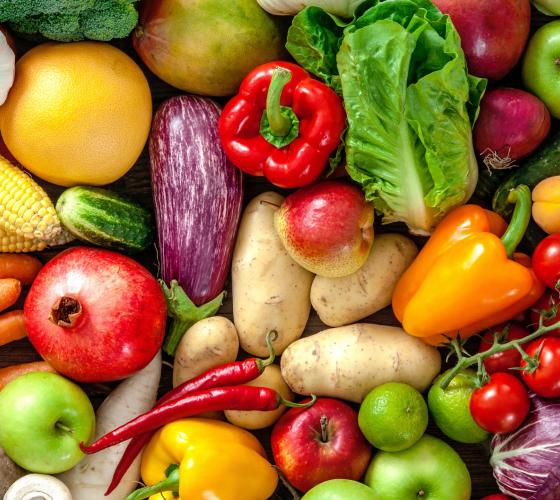
You ever hear the phrase, “You are what you eat”?
Putting the wrong foods in your body will affect every part of it, both inside and outside. This includes:
- Energy Levels: Food is fuel for your body. Think of yourself as a car. You can’t drive far or fast without enough fuel. And the type of fuel matters too!
- Mood: Have you ever been “hangry”? Not enough food or too little of certain foods can drastically affect your mood because your brain constantly needs energy. Eating well is a quick and easy mood booster that can improve your focus, attention, and learning abilities.
- Protect Against Illness: Your body’s natural defense against illnesses is a system called the immune system. Like every system in your body, it needs the right parts to work well. Those parts come in the form of energy, vitamins, and minerals from the food you eat!
- Prevent Long Term Health Conditions: The best way to avoid long term conditions like diabetes, heart disease, and obesity is to practice a healthy lifestyle. Exercise is great for this (so pat yourself on the back for joining PCR!). But so is eating the right foods in the right amounts. (4)
While eating french fries won’t turn you into a potato, they certainly could make you feel like one!
So what are the right foods? And what are the right amounts? Let’s talk about what healthy nutrition looks like and how you can become a healthier, happier person and a stronger rower.
The 3 Types of Fuel
All foods are made up of a mixture of proteins, fats, and carbohydrates. These 3 nutrients are the main fuels that the body uses to power actions like movement, growth, and repairing damage. Together, these are called macronutrients (macro- meaning “big”), and you’ll see that each has its own role in your daily life.
In these next sections, we’re going to about each macronutrient: what they are, healthy food options, and how much you should eat of them to maximize your potential
Proteins are the Building Blocks
What is protein?
Proteins are the basic structural and functional components of your body. When we train, we actually cause tiny amounts of damage to our muscles.(1) This damage is actually beneficial because it tells the body that it needs to make stronger muscles.
Our bodies depend on the proteins we eat to repair and grow our muscles. If you don’t get enough protein, you won’t get stronger from your workouts!
What are some good protein sources?
“Chicken, chicken, and more chicken.”
Meat is the top answer to this question, but you don’t have to bore yourself with chicken at every meal. Any meat is a good source of protein as long as it is lean, which means it is low in fat.(1) Good examples of lean meats are chicken breast, turkey, lean ground beef, pork tenderloin, tuna fish, and shrimp.
But don’t stress if you can’t or don’t want to eat meat!
Eggs are an “egg-cellent” source of protein as well. Dairy products like milk, cheese, and yogurt are great sources too, just try to go for low-fat options.
Are you vegetarian or vegan?
It is a myth that you can’t get enough protein from vegetable sources. Soy-based foods, such as tofu, or beans will be your go-to protein sources. The main concern is to try to eat several vegetarian protein sources to ensure you get enough since they are not as concentrated in protein as meats, eggs, or dairy.
How much protein do you need?
All macronutrient recommendations are made in terms of grams (g). The exact method for finding your daily protein recommendation is to follow a formula based on your body weight in kilograms (kg). Liz Fusco, USRowing’s very own nutrition expert, says that youth athletes need 1.0 - 1.5 g of protein per kg of body weight. This is true regardless of gender or sex. (1)
For example, let’s say you are 155 lbs. To find your weight in kilograms, you can google a quick conversion or divide your weight in pounds by 2.205. This means a 155 lbs person is about 70 kg. That would mean you need between 70 - 105 g of protein a day.
You might be thinking, “That’s a lot of math and measuring to do, and I don’t even know what a gram looks like.”
And you’d be absolutely right. I don’t even know what 1 gram of meat looks like.
But there’s a simple and easy trick you can use! One serving of meat or fish can be anywhere between 20-30 g of protein. One serving of protein also happens to be about the size of your palm. So, to estimate the amount of protein you need per meal, take a serving about the size of your palm! (1)
So, if you eat 4 meals a day (breakfast, lunch, pre-workout snack, dinner) and follow the palm method, you will easily hit or exceed that goal. (5)
Fats are Not The Bad Guys
What are fats?
Fats get a lot of hate. But do they deserve it?
Our bodies absolutely require fat. Fats are tools our bodies use to fill the jobs that proteins can’t do. We also need them to absorb the vitamins and minerals in our foods. Fats make up important parts of your nerves, blood, and muscles. Lastly, they are packed full of energy for those long workouts! (2)
Skipping out on fats means we lose all these positive benefits and our bodies won’t work as well as they should.
What are some healthy fats?
There are 3 types of fats that you should know about.
Unsaturated fats are essential fats that most people think of when we talk about healthy fats. They are essential because our bodies can’t make them on their own, so we completely rely on our food sources for them. Good sources of unsaturated fats are olive oils, nuts, seeds, and the very popular avocado. You could also eat fatty fish like salmon, which would also count as your source of protein! (2)
Saturated fats are often made out to be the bad guys because it is easy to eat too much. Our bodies don’t need them to survive since we can make some on our own. They are found in fatty meats like burgers and bacon, whole-fat dairy, and many baked goods since they’re made with butter. (2)
Trans fats are the third type and are the real bad guys.
Trans fats are manmade and not found in nature. Your body can’t use trans fats to do any of the normal jobs that fats do, so they are essentially useless. In fact, they can put you at risk for heart disease, strokes, and diabetes. Trans fats are found in highly processed foods, like packaged desserts and french fries. You simply don’t need them! (2)
How much fat do you need?
First of all, choose unsaturated fats over saturated fats whenever possible. For example, try swapping out that swab of butter on your morning toast with some nutrient-dense peanut butter. (1)
Problems occur when people eat too much fat because fats pack a lot of energy in a tiny amount. Any energy you don’t use gets stored as body fat, regardless of its source. For the positive benefits of fats, you don’t need to eat a whole lot of them.
The basic recommendation is about 25-30% of your daily calories come from fat. That means 1 serving per meal. A helpful trick is to use a dinner spoon (the bigger of the 2 spoons) to estimate a tablespoon, which is often enough to be a serving of fat.
For example, if a serving of peanut butter is 2 tablespoons, take 2 modest spoonfuls with a dinner spoon.
Fuel up with carbs
What are carbs?
Carbohydrates, or carbs for short, are your body’s main fuel source. If your body is a car, carbs are the gas that powers the engine. No gas means you’re not going very far or very fast.
Carbs come in many shapes and forms. This includes vegetables, fruits, complex carbs, and simple carbs.
You absolutely need fruits and vegetables in your diet. They are filled with the vitamins and minerals that your body needs to function and fight off diseases. They also contain fiber, which is a special carb that helps make you feel full and helps you poop (which is good!). (1)
Complex and simple carbs are your “grains” options that will provide most of your energy during exercise.
Complex carbs provide sustained energy over a long period since they contain fiber, which slows down the rate of digestion. Simple carbs are simple because they are usually just carbs with no fiber. This means our bodies digest them as a quick energy source. We do have a need for them (like right before and after a workout), but you will quickly run out of energy if that is all you eat. (1)
What are some good sources?
When it comes to fruits and vegetables, I want you to eat a rainbow of colors!
Colorful foods are full of vitamins and minerals, and each color represents a different type of vitamin or mineral. The more colors you eat in a meal, the better! Strive to get 3 colors in at mealtime and at least 1 color if you’re having a snack (like fruit). (1)
The complex carbs are your whole grain options. Basically anything that has whole or brown in front of its name is a complex carb. Examples include whole-wheat bread, whole wheat pasta, and brown rice, but also oatmeal.
Simple carbs include grains like white bread, pasta, rice, and potatoes. They are also in snacks like crackers and pretzels. Sugar is the simplest of the simple carbs, and it is found in high amounts in gummies, juices, and sports drinks.
How many carbs do you need?
It depends!
You need fruits and vegetables every day to make sure you get enough vitamins and minerals. But the complex and simple carb amounts depend on how active you are. (1)
If carbs are fuel, then it makes sense that you need more carbs on days you exercise and less on days you don’t. When I was rowing in college, I could easily eat a whole box of pasta in one day - that’s 8 servings of carbs and nearly 1,600 calories!
Because it is so hard to estimate how many carbs athletes need to stay energized, nutrition experts have come up with a useful tool called the Athlete’s Plate.
An Athlete’s Plate
I first heard of the Athlete’s Plate during a class with USRowing’s nutrition expert Liz Fusco at a high-performance rowing event.
The Athlete’s Plate was made by experts at the United States Olympic Committee and the University of Colorado. Sounds fancy, right? It is a more useful tool than the USDA’s Food Pyramid or MyPlate tools because it includes your exercise level when making up your meals.
By using the Athlete’s plate, you can easily build a healthy meal that will hit all of the recommendations that I’ve talked about. No math needed! All you have to do is fill your plate so it looks like the pictures.
The Athlete’s Plate tool consists of 3 pictures you use to make a plate of food. Choose the picture that matches the amount of exercise you plan on doing that day.
Easy Days
Easy days are days you aren’t working out.
You can see that fruits and veggies should make up half your plate. A quarter of it should be your protein, and the last quarter should be complex carbs. Complex carbs are suggested because of the extra fiber they have, but it is okay if you don’t have any of those.
Fats are shown in the top left corner as spoonfuls. Note that teaspoons would be about a scoop of a small spoon, not a dinner spoon.
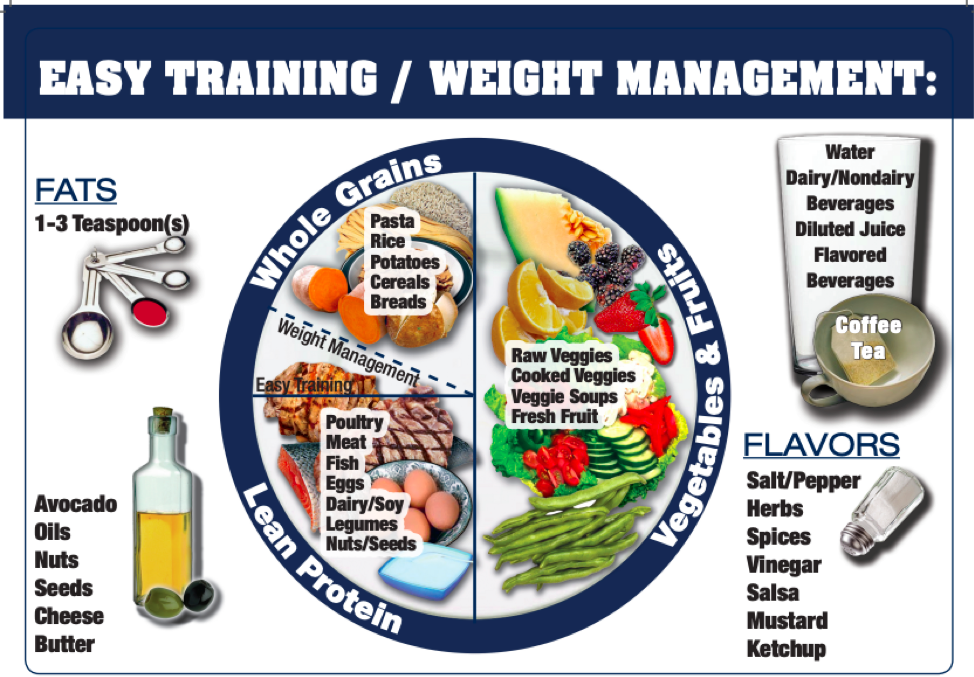
(3)
Moderate Days
Moderate days are days when you’re exercising once, for any time period less than 2 hours. This is what you should be using on days you have practice.
The protein amount hasn’t changed, but now the plate is about ⅓ grains and ⅓ vegetables. Fruits are now served on the side, and you should aim for 1 piece per meal.
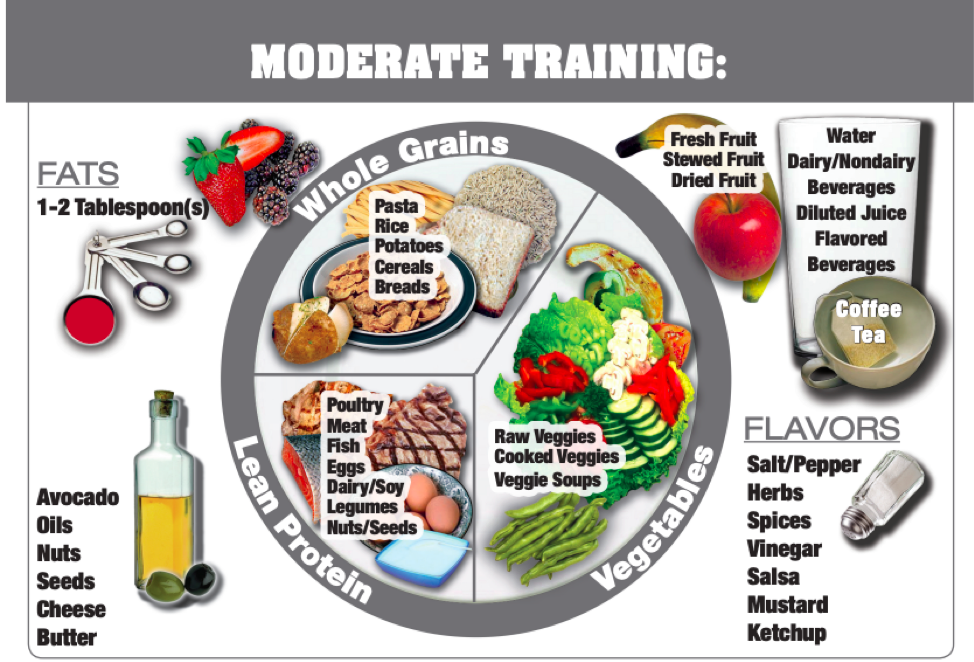
(3)
Hard Days
Hard training days are those when you have 2 practices a day or 3+ hours of exercise. It also includes race days when you may be racing multiple times (3 or more) in a short time.
Again, the protein amount is the same. Veggies are reduced to about a quarter of the plate, and fruits and fats are still shown on the sides.
The big difference here is that half the plate is now grains. Because you are working out so much, having simple carbs is an advantage since they can be digested quickly.
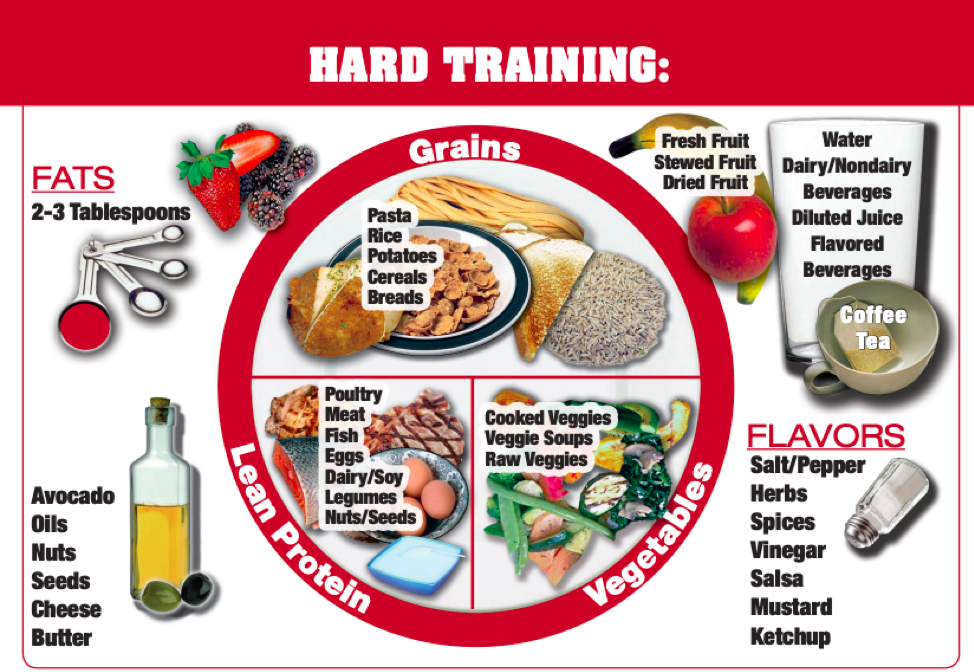
(3)
Putting It All Together
This is a lot of information, some of it old and some of it new to you. It’s a lot to take in!
I encourage you to make small changes first. You’ll be surprised how big an impact they will make. Use the Athlete’s Plate to make these changes easier to remember and use in your daily life.
If you take these tips, you will perform better as a rower, but also be a happier and healthier person!
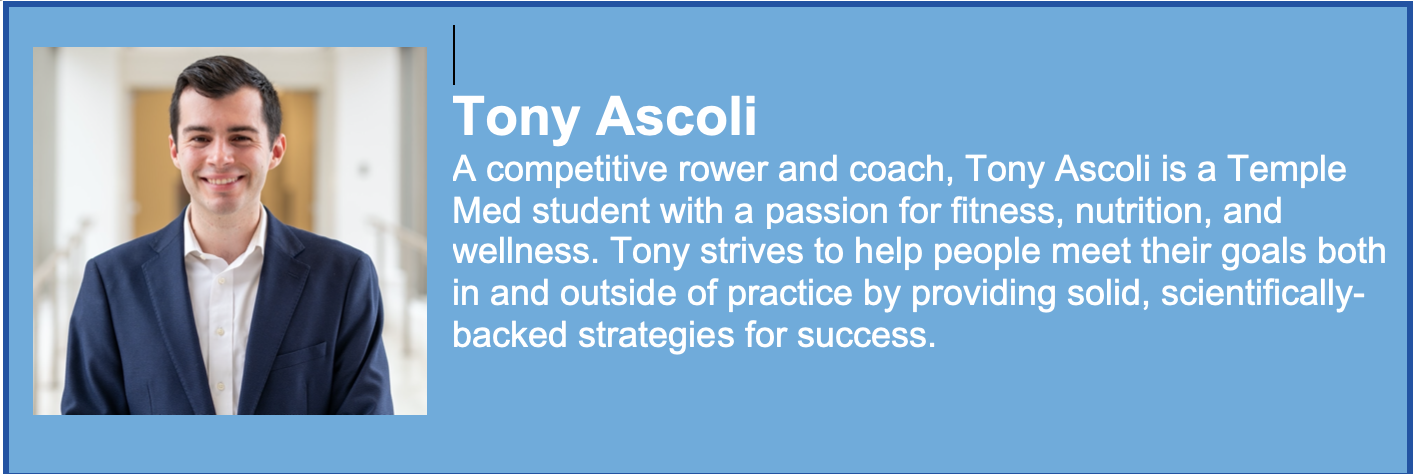
References
- Fusco, Liz. 2020. Eat Like a Champ! A Free USRowing Webinar with Liz Fusco, MS, RDN [Video]. USRowing. https://youtu.be/tXCtnh1uFg4.
- Harvard Health Publishing. 2019. The truth about fats: the good, the bad, and the in-between. Harvard Medical School. https://www.health.harvard.edu/staying-healthy/the-truth-about-fats-bad….
- Meyer, Nanna. 2020. The Athlete’s Plate. United States Olympic Committee Sports Dietitians and the University of Colorado Sports Nutrition Graduate Program. https://www.uccs.edu/swell/theathletesplate
- Clark, Nancy. 2014. “Eating to Stay Healthy for the Long Run” in, Sports Nutrition Guidebook. 5th edition. Newton, MA: Sheridan Books.
- Andrews, Ryan, and St. Pierre, Brian. 2020. Forget Calorie Counting: Try this calorie control guide for men and women. Precision Nutrition. https://www.precisionnutrition.com/calorie-control-guide